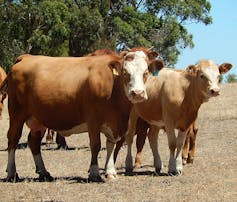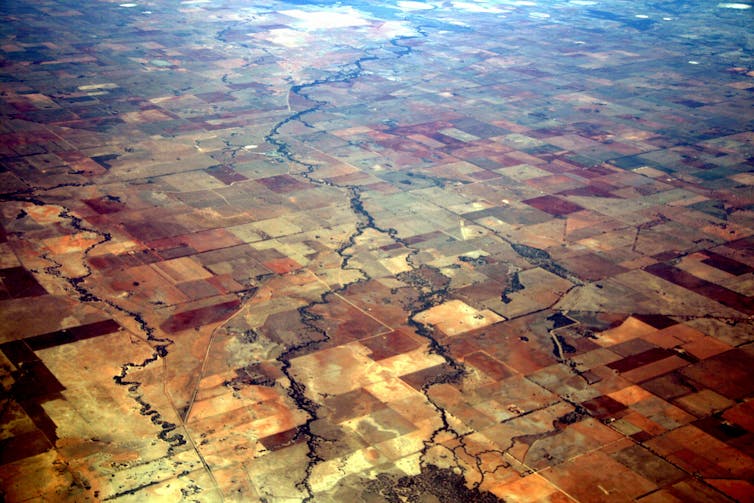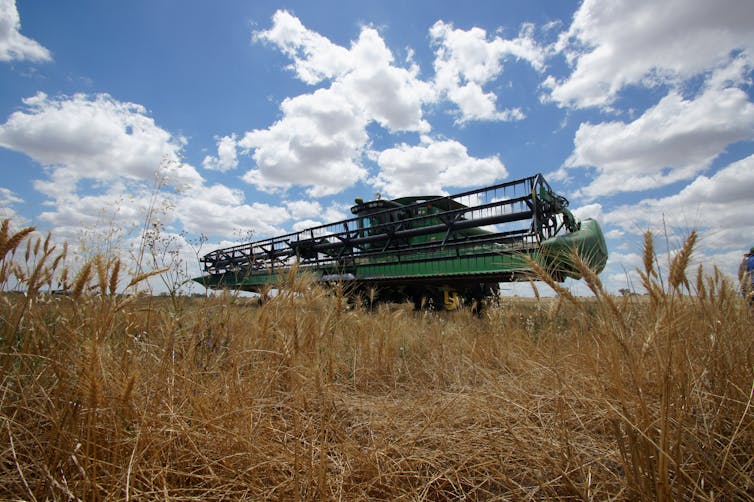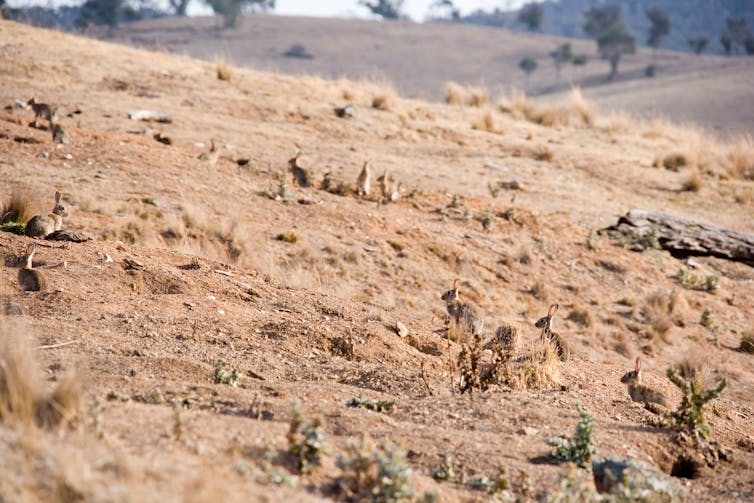AUSTRALIA 2025: How will science address the challenges of the future? In collaboration with Australia’s chief scientist Ian Chubb, we’re asking how each science discipline will contribute to Australia now and in the future. Written by luminaries and accompanied by two expert commentaries to ensure a broader perspective, these articles run fortnightly and focus on each of the major scientific areas. In this final instalment, we examine our agricultural legacy.
Food and agriculture are fundamental to human survival and it was the birth of agriculture and farming that laid down the basis for human civilisation.
Since the first crops were domesticated around 10,000 years ago, advances in agriculture have been intimately linked with human development and the growing world population.
Technology and innovation have underpinned those advances. Since the Green Revolution in the early 1960s crop production has increased nearly two and a half times, from 1.84 billion tonnes to 4.38 billion tonnes in 2007, achieved on only 11% more cropped land.
Agriculture today is a very sophisticated and highly technical industry, and in Australia it has been one of our most innovative and efficient industries. Our farmers have remained competitive in a global food market despite Australia having low levels of subsidies relative to our major competitors.
The ability of this industry to adapt, innovate and form successful collaborations will continue to support a strong and prosperous Australia with sustainable food security.
Breeding and feeding
For Australia, food security is inextricably linked to the political stability of our region and has the potential to affect our national security.

Food security also affects our status as a premier food exporting nation and the health and wellbeing of our population. The likelihood of a food crisis directly affecting Australia is remote given that we have enjoyed cheap, safe and high quality food for many decades and we produce enough food today to feed 60 million people – three times our current population.
Although we account for only about 3% of the global food trade, our food exports are worth more than A$30 billion annually and we are one of only 11 countries that are net food exporters.
While these are comforting statistics and our agricultural products are important, when put into a global context, we produce enough to feed only 2% of the Asian population, so we cannot claim, now or even potentially, to be the “food bowl of Asia”.
Addressing the global food security problem will depend upon the development and delivery of technologies that lead to increased food production. But this must be achieved without increasing the area under production, since arable land is now limited, and under conditions where the frequency and severity of climate “shocks” are likely to increase due to the effects of climate change.
Being realistic about growth
Our previous reliance on water and energy to drive up yields is not an option for the next phase of productivity gains.
Agriculture has an excellent record of productivity growth over the past 50 years, allowing global production to meet the large population increase and, for countries such as Australia, these gains have kept food prices low while keeping farmers in business.

Agricultural production has remained important to our economy because we have effectively developed and delivered new technologies through a strong research base and a highly skilled and innovative farming community. In particular, we have been able to maintain our position even though we produce food on the driest inhabited continent, on low quality soils and with continual climate variability.
Our agricultural R&D capability ranks among the best in the world, and more recently Australia has developed a strong capability in climate change research including studies on impacts, adaptation and mitigation. We can now implement this capability to enhance agricultural production both in Australia and in our region.
These strengths provide a solid foundation to catalyse transformation of the agricultural industries to address regional food security. Australia can make a significant contribution to the task because we have extensive experience in dealing with difficult and low input productions systems.
Our record in applying this experience may not have been perfect but we are now making serious attempts to address our past omissions. Indeed, we will have little choice given the predicted impact of climate change on our agricultural production regions.
Off the farm and into the laboratory
Our future in food production will lie within our current large scale farming systems where we have clear skills and where there is scope for increased efficiency rather than niche foods where high labour costs and low innovation make it hard for us to complete.
Over the next decade we will move to a scene where engineering and biology are intimately linked. Satellites will provide data on crop and rangeland health and productivity. This information will be combined with ground data and used as the basis for farm management decisions.

We will know the detailed genetic makeup of our farm animals and our crops and will use the association between genotype (the genetic makeup) and phenotype (the physical characteristics) to predict performance under a diverse set of environmental conditions.
This information will feed into the decisions made by breeders to develop new crop cultivars or animal breeds to optimise the use of available resources while minimising the environmental impact of farming.
This move towards the utilisation of more specialist skills in agriculture is evident even today. Nowadays research teams look very different to those of the past.
If you were to set up a team today to develop a strategy to breed wheat with enhanced drought tolerance, your team will need to include software programmers, computer scientists, statisticians, crop physiologists, agronomists, cell biologists, pathologists, molecular biologists and geneticists.
Ideally you would also collaborate with climate scientists to understand the future production environments and help predict how your new varieties will perform.
The expectations of these scientists is also changing: a modern agronomist will need the traditional knowledge of cropping systems, fertiliser regimes, field pathology and so on but will also know techniques for assessing crop health based on analysis of the light reflected from crops and captured on images generated from drones or satellites.
Farmers are already using computer models to assess the status of their soils, crops and farming systems to support their decision making.
In the future farmers will also be capturing data from even more diverse sources, linking this to genetic information and predictive climate models and using the result to help them decide when to sow their crops, when to apply fertilisers, how to protect crops from disease and when to harvest.
Investments and pay-offs
Perhaps our greatest contribution to agricultural innovation will be through developing solutions to global food security challenges and delivering these solutions to partners around the world. Agriculture is so important to human survival that there is huge global investment in research at around US$40 billion annually, largely from the private sector.
Although Australia currently accounts for only 1% of this investment, we are frequently sought out as a partner for both the public and private sector overseas. Our agricultural research capability has the potential to become a significant industry in its own right.

Over the next decade we should build management, regulatory and support structures that allow us to capitalise on this international interest and build strong multinational research programs that can not only support food security in our region but also ensure our farmers have access to the latest technologies.
Agriculture is among our most technologically advanced industries, yet most Australians are largely unaware of the revolution that is occurring on our farms.
Many would be both surprised and fascinated to know just how sophisticated agricultural science has become and the role it plays in delivering the strong and prosperous Australia of the future.
Michael D'Occhio, Professor at University of Sydney
The world is rapidly reaching the boundaries of agricultural land and the sustainable intensification of agriculture has emerged as a necessity to meet the increase in global demand for food. Given the limits to natural resources the world simply cannot afford to sustain the loss of food that is caused by diseases of plants and animals.
Currently, diseases (bacterial, viral, fungal) cause general losses of 20-40% of horticultural crops, 10-15% of grains, up to 50% of aquaculture and more than 20% of livestock worldwide.
Intensification of food production tends to exacerbate the occurrence and impact of diseases, and climate variability and change has introduced another layer of complexity in the emergence and spread of diseases.

The success of agriculture in Australia has been due, in part, to the relative freedom from diseases that impact food production elsewhere. Indeed, the high biosecurity status of Australia ensures safe and healthy domestic food and gives Australia preferred status in global food markets. Diseases involve many of the sciences such as immunology, pathology, genetics, epidemiology, public health and sociology.
While Australia is free of many food diseases there is considerable domestic, world-class expertise in the science of animal and plant diseases. This expertise has a very important role in ensuring that Australians continue to have safe, nutritious and healthy food and are protected from animal to human transmission of diseases (zoonoses).
Other important roles are creating new knowledge on diseases to prepare for future challenges and training the next generation of scientists and teachers. There is a broader role in the global community in food and nutritional security and human health, including through partnerships with developing countries in education, training, research and technology transfer.
Dana Cordell, Chancellor’s Postdoctoral Research Fellow at University of Technology Sydney
An imminent food boom to replace the mining boom in Australia is expected to double agricultural outputs to feed growing Asian demand. Much discussion and swift debate about this economic opportunity has ensued in the past 12 months alone at the GAP Food Summit, Australian Bureau of Agricultural and Resource Economics and Sciences (ABARES) Outlook 2014 and Global Food Forum, demonstrating our responsiveness and entrepreneurship.
But a longer-term strategy based on genuine scientific inquiry is also needed to answer fundamental questions like where would the land, water, nutrients and farmers come from? The expert knowledge of agricultural scientists can help Australia “farm smarter, not harder”.
Unlocking the “soil bank” to access stored nutrients from past decades of fertiliser application can increase agricultural productivity and reduce farmers’ vulnerability to fluctuations in climate and fertiliser availability. This contributes to a prosperous and healthy Australia, and, meets our moral commitment to food security in the region.
The next generation of scientists may have more complex and wicked challenges to address, but this need not require being born a genius: at a recent Global Young Scientist Summit I attended that brought together 16 Nobel Prize Laureates to share their secret to success, it essentially boiled down to one word: curiosity.
In the words of novelist and professor of biochemistry at Boston University Isaac Asimov:
The most exciting phrase to hear in science, the one that heralds the most discoveries, is not “Eureka!” [I found it!] but “that’s funny…”.
This article is part of the Australia 2025: smart science series, co-published with the Office of the Chief Scientist. Further reading:
Australia’s future depends on a strong science focus today
Physics: a fundamental force for future security
Proteins to plastics: chemistry as a dynamic discipline
Optimising the future with mathematics
Australia can nurture growth and prosperity through biology
A healthy future? Let’s put medical science under the microscope
Groundbreaking earth sciences for a smart – and lucky – country
To reach for the stars, Australia must focus on astronomy
Marine science: challenges for a growing ‘blue economy’
Building the nation will be impossible without engineers
Australia’s got ICT talent – so how do we make the most of it?
Statistics is more than a numbers game – it underpins all sciences

